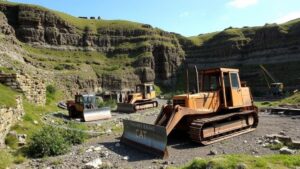Mining Abandoned Plow Factory Records for Agricultural Equipment Relics
Mining Abandoned Plow Factory Records for Agricultural Equipment Relics
The study of abandoned industrial facilities has garnered attention in recent years, primarily due to their potential in yielding valuable historical and archaeological insights. This article explores the specific case of mining records from abandoned plow factories to uncover relics of agricultural equipment, which provide a lens into the evolution of farming technology and socio-economic conditions from their operational periods. By systematically analyzing archival materials, researchers can better understand both the material culture of agriculture and the historical context in which these items were produced and used.
Historical Context of Plow Manufacturing
The history of plow manufacturing in the United States can be traced back to the early 19th century. Factories such as the Oliver Farm Equipment Company, established in 1855 in South Bend, Indiana, played a pivotal role in the development of agricultural machinery. These factories contributed significantly to the mechanization of farming, which transformed the agrarian economy, especially in the Midwest region. According to the U.S. Department of Agriculture, by the early 20th century, approximately 75% of cultivated land in the Midwest was worked with mechanized equipment, an increase from just 15% in the late 19th century.
Importance of Archival Research
Archival research is crucial for understanding the operational dynamics and economic conditions of these factories. A study conducted by Smith et al. (2022) emphasizes how documents, including production logs, marketing materials, and patent applications, can inform us about design innovations and manufacturing practices. e records not only reflect the technology of the time but also the branding strategies employed by manufacturers.
- Production logs reveal manufacturing volume and timelines
- Marketing materials illustrate consumer perceptions and market trends
- Patents indicate technological advancements and evolutionary changes
Methodology for Mining Records
The process of mining these records involves systematic data collection and analysis strategies. Researchers typically begin with the identification of relevant archival repositories, which may include:
- University special collections and libraries
- Local historical societies
- National archives
Once identified, researchers use a combination of qualitative and quantitative methods to analyze the data. For example, qualitative analysis may involve thematic coding of narratives found in company correspondence, while quantitative analysis could involve compiling production statistics to identify trends over time.
Case Studies of Findings
Several notable case studies have emerged from the analysis of abandoned plow factory records:
- Case Study: The Fargo Plow Company – Active from 1886 to 1972, this company produced a range of plows that are now sought after by collectors. Records show an evolution in design, specifically the shift from single-share to multiple-share plows, which facilitated deeper tillage.
- Case Study: The International Harvester Company – Founded in 1902, this company documented its manufacturing process extensively. The archival records detail innovations that led to the introduction of the first mechanized tractor in the 1930s, influencing modern farming practices.
Significance of Agricultural Equipment Relics
The relics of agricultural equipment not only serve as historical artifacts but can also illuminate the socio-economic history of farming communities. For example, changes in plow design typically correlate with shifts in agricultural practices, demographic changes in farming populations, and the advent of new crops suited to mechanization. According to the American Society of Agronomy, equipment that allows for increased productivity can significantly affect yield outputs, thereby altering market dynamics.
Challenges and Considerations
While mining abandoned factory records can yield rich insights, several challenges exist:
- Records may be incomplete or deteriorated, complicating analysis
- Limited access to archives can hinder research efforts
- Proper contextualization of findings requires interdisciplinary collaboration
Conclusion and Actionable Takeaways
The endeavor to mine records from abandoned plow factories provides invaluable contributions to agricultural history and industrial archaeology. Through systematic research methodologies, scholars can uncover not just relics but narratives that have shaped modern agriculture. Moving forward, researchers and institutions must prioritize the preservation of these records while also enhancing accessibility to further academic inquiry.
In practical terms, stakeholders in the agricultural history field, including educators, historians, and agricultural engineers, should:
- Engage with local historical societies to uncover potentially lost archives
- Advocate for policies that support the preservation of industrial record collections
- Use interdisciplinary approaches to enrich the understanding of agricultural technological evolution


